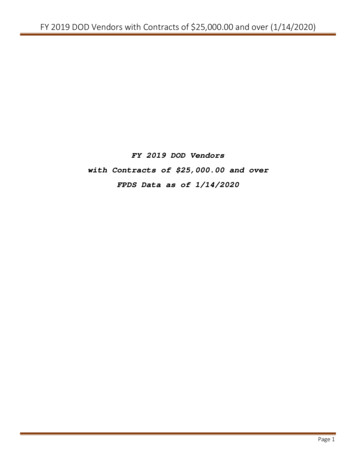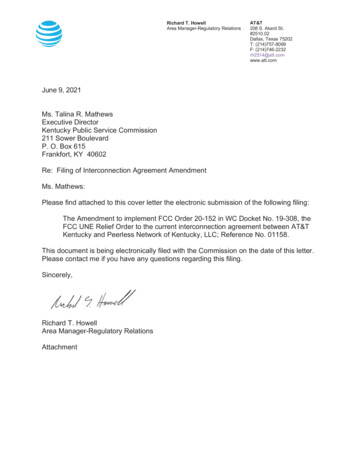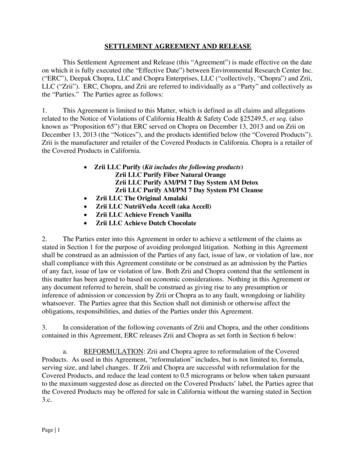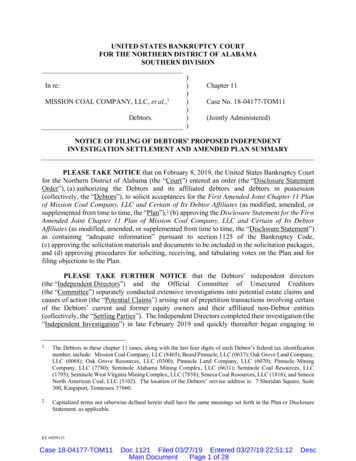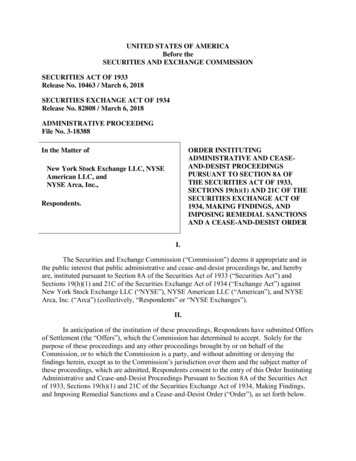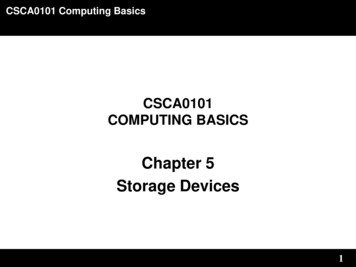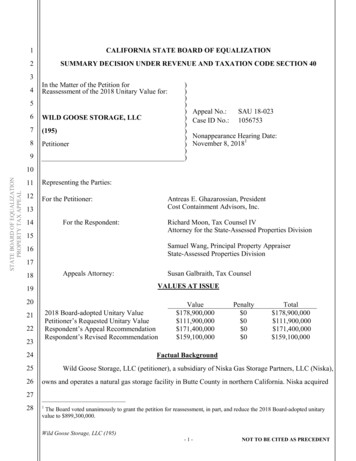
Transcription
1CALIFORNIA STATE BOARD OF EQUALIZATION2SUMMARY DECISION UNDER REVENUE AND TAXATION CODE SECTION 4034In the Matter of the Petition forReassessment of the 2018 Unitary Value for:56WILD GOOSE STORAGE, LLC7(195)8Petitioner9))))))))))))Appeal No.:Case ID No.:SAU 18-0231056753Nonappearance Hearing Date:November 8, 20181STATE BOARD OF EQUALIZATIONPROPERTY TAX APPEAL1011Representing the Parties:12For the Petitioner:Antreas E. Ghazarossian, PresidentCost Containment Advisors, Inc.13For the Respondent:14Richard Moon, Tax Counsel IVAttorney for the State-Assessed Properties Division15Samuel Wang, Principal Property AppraiserState-Assessed Properties Division1617Appeals Attorney:18Susan Galbraith, Tax CounselVALUES AT ISSUE19202018 Board-adopted Unitary ValuePetitioner’s Requested Unitary ValueRespondent’s Appeal RecommendationRespondent’s Revised Recommendation21222324Penalty 0 0 0 0Total 178,900,000 111,900,000 171,400,000 159,100,000Factual Background2526Value 178,900,000 111,900,000 171,400,000 159,100,000Wild Goose Storage, LLC (petitioner), a subsidiary of Niska Gas Storage Partners, LLC (Niska),owns and operates a natural gas storage facility in Butte County in northern California. Niska acquired27281The Board voted unanimously to grant the petition for reassessment, in part, and reduce the 2018 Board-adopted unitaryvalue to 899,300,000.Wild Goose Storage, LLC (195)-1-NOT TO BE CITED AS PRECEDENT
1petitioner in July 2016. After the purchase, a purchase price allocation (PPA) allocated 291 million of2the purchase price to petitioner’s fixed asset accounts. (SAPD’s Analysis for Appeals Attorney, p.1;3Petition, p. 1.) The 2018 Board-adopted unitary value of petitioner’s facility is based on 50 percent4reliance on the Reproduction Cost Less Depreciation (ReproCLD) value indicator and 50 percent5reliance on the Capitalized Earning Ability (CEA) value indicator. As noted, the petitioner raised three6issues in its petition and respondent and petitioner are in agreement as to Issue 1 and Issue 2, and are not7in agreement as to Issue 3.STATE BOARD OF EQUALIZATIONPROPERTY TAX APPEAL8Issue 1 addresses whether respondent should allow additional capital expenditures (CapEx) for9equipment replacements in the calculation of the CEA value indicator. Respondent states that it based its10CapEx allowance of 600,000 on petitioner’s own forecast created in 2016 when the gas storage facility11was purchased, that petitioner provided no life study or financial documentation to support its 9.512million projected annual CapEx, that petitioner did not provide sufficient documentation that additional13capital replacements are required to meet new regulations due to the Aliso Canyon gas leak, and14respondent believed a significant portion of petitioner’s fixed assets would already have been retired and15replaced since petitioner’s facility has been in operation for 15 years. In fact, petitioner has not retired16many of its fixed assets. After filing its original SAPD analysis, respondent reviewed the new17information from petitioner and determined that the 600,000 allowance was regular maintenance and18repair costs. Respondent thereafter estimated the appropriate CapEx for petitioner’s CEA calculation to19be 4.6 million annually. Petitioner is in agreement with respondent’s revised CapEx for the CEA20calculation.21Issue 2 addresses whether respondent should allow a business inventory adjustment in the22calculation of the CEA indicator. Petitioner claims that an allowance for business inventory should be23made for natural gas that is purchased, stored, and sold for the purpose of utilizing storage capacity,24injection, and withdrawal capacity. Since business inventories are exempt from taxation under section25129 of the Revenue and Taxation Code, the Unitary Value Methods (March 2003) handbook allows a26deduction from net income of the average inventory amount. Based on information provided during the27appraisal and in the petition, respondent reduced the CEA value indicator to reflect the average business28inventory exemption allowance, and petitioner is in agreement with this reduction. After the reductionWild Goose Storage, LLC (195)-2-NOT TO BE CITED AS PRECEDENT
1recommended for both Issue 1 and Issue 2, the CEA value indicator is 115,582, 643, a reduction of2 39,567,142.34Legal Issue: Whether petitioner has shown that respondent failed to place proper reliance on the5CEA value indicator for lien date 2018.6Findings of Fact and Related ContentionsSTATE BOARD OF EQUALIZATIONPROPERTY TAX APPEAL7Petitioner contends that respondent has not placed proper reliance on the cost and income value8indicators for lien date 2018, and, as a result, the Board has overstated the value of petitioner’s property.9Petitioner asserts that respondent’s 50 percent reliance on the cost indicator and 50 percent reliance on10the CEA value indicator is not appropriate. Petitioner states that “in an open market, any willing buyer11will base their decision on the earnings ability of a potential investment to make a decision to invest.12With this in mind, it is our opinion that a majority of the weight should be placed on the earnings13capability.” (Petition, p. 5.) Accordingly, petitioner requests a 75 percent reliance on the CEA value14indicator and a 25 percent reliance on the cost indicator, resulting in an additional reduction of15 47,200,000 from respondent’s revised recommended value resulting in petitioner’s requested value of16 111,900,000.Respondent contends that 50 percent reliance, and not 75 percent reliance, on the CEA value1718indicator is appropriate for petitioner’s unitary property as of lien date 2018. Respondent cites Property19Tax Rule2 6, which provides that when a facility is new, the cost indicator is normally a more reliable20value indicator and should generally be given greater reliance. Rule 8, subdivision (a), provides that the21income approach to value is used in conjunction with other approaches when the property under22appraisal “has an established income stream or can be attributed a real or hypothetical income stream by23comparison with other properties.” Respondent also refers to Assessors’ Handbook section 502,24Advanced Appraisal (AH 502) (Dec. 1998, reprinted Jan. 2015), which discusses the criteria an25appraiser should consider when reconciling value indicators, including the appropriateness of the value26indicator, the accuracy of the data and adjustments, and the quantity of evidence available for each value27282All references to Property Tax Rules or Rule are to sections of title 18 of the California Code of Regulations.Wild Goose Storage, LLC (195)-3-NOT TO BE CITED AS PRECEDENT
1indicator. Respondent asserts that greater reliance is placed on the cost approach when the property is2new, and on the CEA value indicator once the facility has established a sufficient positive earnings3history, or earnings that can be reasonably and accurately forecasted. (SAPD’s Revised Analysis for4Appeals Attorney, p. 4.)STATE BOARD OF EQUALIZATIONPROPERTY TAX APPEAL5Respondent considered the cost approach to be reliable since petitioner’s acquisition and PPA6were completed less than two years ago and the purchase price was allocated to the fixed asset accounts7according to their fair market value at that time. Respondent also allowed a 24.5 percent economic8obsolescence adjustment based on an income shortfall method by comparing petitioner’s expected9income at the time of the acquisition and the current expected income, which is consistent with Board-10published Guidelines for Substantiating Additional Obsolescence for Sate-Assessed Telecommunication11Properties.312Additionally, respondent considered that the gas storage industry in general has suffered13financially due to the stabilized price in the natural gas market. (SAPD’s Revised Analysis for Appeals14Attorney, p. 4.) Petitioner also recognizes that recent growth in shale gas production has resulted in15lower gas prices and reduced price volatility, and that the increased availability of natural gas supplies16reduced the reliance on natural gas storage facilities as a supply source in winter. (Petition, p. 2.)17Respondent states that, in order to capture all forms of obsolescence, respondent placed 50 percent18reliance on the cost value indicator and 50 percent on the CEA value indicator since petitioner had two19years of positive and consistent earning history. However, respondent asserts that since the current20owner has owned the facility for less than two years, coupled with the relatively high degree of21uncertainties in the gas storage industry, placing additional reliance on the CEA value indicator is22inappropriate.23Finally, respondent states that petitioner has not provided documentation to support its request24for 75 percent reliance on the CEA value indicator and 25 percent reliance on the cost value indicator,25and therefore respondent recommends that no adjustment be made for Issue lescence Guidelines.pdfWild Goose Storage, LLC (195)-4-NOT TO BE CITED AS PRECEDENT
12Burden of Proof3Assessing officers are presumed to have properly performed their duties. (Evid. Code, § 664.)4Therefore, Petitioner has the burden of showing that the assessment is incorrect or illegal. (ITT World5Communications v. Santa Clara (1980) 101 Cal.App.3d 246; see also Cal. Code Regs., tit. 18, § 5541,6subd. (a).)7Reconciliation of Value Indicators8Property Tax Rule 3 requires that, in estimating value, the assessor shall consider one or more9STATE BOARD OF EQUALIZATIONPROPERTY TAX APPEALApplicable Law and Appraisal Principlesof the approaches to value “as may be appropriate for the property being appraised,” which includes the10comparative sales approach, the replacement or reproduction cost approach (e.g., ReplCLD valuation11methodology), or the income approach. The appropriateness of an approach is often related to the type12of property being appraised and the available data. (Assessors’ Handbook section 502, Advanced13Appraisal (December 1998) (AH 502), p. 109.) In addition, the validity of a value indicator will depend14upon the accuracy of data and adjustments made to the approach. That is, the accuracy of a value15indicator depends on the amount of available comparable data, the number and type of adjustments, and16the dollar amount of adjustments. Finally, if a large amount of comparable data is available for a given17approach, the appraiser may have more confidence in that approach. For example, if income, expense,18and capitalization rate data can be obtained from many properties comparable to the subject, the19appraiser may attribute significant accuracy to the income approach. The greatest reliance should be20placed on that approach or combination of approaches that best measures the type of benefits the21subject property yields. The final value estimate reflects the relative weight that the appraiser assigned,22either implicitly or explicitly, to each approach. (AH 502, p. 112.)23Income Approach to Value24Property Tax Rule 8, subdivision (a), states that “the income approach is used in conjunction25with other approaches when the property under appraisal is typically purchased in anticipation of a26money income and either has an established income stream or can be attributed a real or hypothetical27income stream by comparison with other properties.” Subdivision (b) describes the income approach to28value as the valuation method whereby, “an appraiser values an income property by computing theWild Goose Storage, LLC (195)-5-NOT TO BE CITED AS PRECEDENT
STATE BOARD OF EQUALIZATIONPROPERTY TAX APPEAL1present worth of a future income stream. This present worth depends upon the size, shape, and duration2of the estimated stream and upon the capitalization rate at which future income is discounted to its3present worth.” Subdivision (c) provides that “the amount to be capitalized is the net return which a4reasonably well-informed owner and reasonably well informed buyers may anticipate on the valuation5date that the taxable property existing on that date will yield under prudent management and subject to6legally enforceable restrictions as such persons may foresee as of that date.”7The Reproduction Cost Approach to Value8Property Tax Rule 6, subdivision (a) provides, in part, that: “The reproduction or replacement9cost approach to value . . . is preferred when neither reliable sales data . . . nor reliable income data are10available . . . .” In general, the “reproduction cost of a reproducible property may be estimated either by11(1) adjusting the property’s original cost for price level changes and for abnormalities, if any, or (2)12applying current prices to the property’s labor and material components, with appropriate additions for13entrepreneurial services, interest on borrowed or owner-supplied funds, and other costs typically14incurred in bringing the property to a finished state.” (Property Tax Rule 6, subd. (b).) The resulting15adjusted cost is the reproduction cost new (ReproCN) which is then “reduced by the amount that such16cost is estimated to exceed the current value of the reproducible property by reason of physical17deterioration, misplacement, over or under improvement, and other forms of depreciation or18obsolescence.” (Property Tax Rule 6, subd. (e).)19ReproCN is an estimate of the current cost to replace the existing property with a new property20that is an exact replica, or virtually so, of the existing property. Data for the derivation of the ReproCN21index factors can be obtained either from prices quoted by current vendors of the property or by22applying an appropriate index factor to the historical or original acquisition cost of the property. The23use of published index factors is the preferred method when performing mass appraisals. Numerous24trade publications provide index factors for the conversion of historical cost to ReproCN. The25publishers of these index factors generally survey industry participants and equipment manufacturers26and compare current prices to a historical cost database. The ratio of price change for a given annual27period is the ReproCN index factor.28The calculation of the ReproCLD indicator is basically a two-step process. First, theWild Goose Storage, LLC (195)-6-NOT TO BE CITED AS PRECEDENT
STATE BOARD OF EQUALIZATIONPROPERTY TAX APPEAL1reproduction cost new (ReproCN) is calculated by applying an index factor (also known as “trend2factors”) to the historical acquisition cost of property, segregated by year of acquisition. Second, the3ReproCN is adjusted for normal depreciation by the application of a percent good factor to the4ReproCN. The product of this calculation is the ReproCLD value indicator. (Unitary Valuation5Methods (March 2003), p. 11.)6For the ReproCLD indicator, depreciation is the difference in value between a new identical7substitute property and the existing property. The difference is recognized as the complement to the8percent good factors. Respondent conducts service life studies to assist in determining the appropriate9percent good factors. The usefulness of the ReproCLD in the appraisal process depends on whether or10not the market recognizes an exact replica of the subject property as having adequate utility for the11operational needs of an ongoing business. If there are economical substitutes (i.e., a property of lower12cost or greater utility for the property being appraised), the ReproCLD indicator may not be a reliable13method to determine the fair market value of a subject property.Analysis and Disposition1415Respondent is presumed to have correctly determined the value of the property at issue, and16petitioner bears the burden of proving otherwise. Here, the parties agree on the use of the ReproCLD17and CEA value indicators to value the unitary property, but differ over the appropriate amount of18reliance placed on each value indicator.19Petitioner contends that respondent should place a greater reliance on the CEA value indicator.20Petitioner states that in an open market, any willing buyer will base their decision on the earnings21ability of a potential investment, and therefore petitioner believes that a majority of the weight should22be placed on the earnings capability. However, petitioner provides no documentation in support of its23request that 75 percent reliance be placed on the CEA value indictor.24Property Tax Rule 8 provides that reliance on the income approach is appropriate when the25property has an “established income stream or can be attributed a real or hypothetical income stream by26comparison with other properties.”2728In the view of the Appeals Attorney, the factors and circumstances that affect gas storage prices,as described by petitioner, indicate a high degree of unpredictability in the level of future income.Wild Goose Storage, LLC (195)-7-NOT TO BE CITED AS PRECEDENT
1Hence, the Appeals Attorney finds that petitioner has not shown evidence of a sufficiently established2income stream for the respondent to justify weighting the CEA value indicator 75 percent and the cost3indicator 25 percent, and has not presented evidence to show that the property may be attributed a real4or hypothetical income stream by comparison with other properties. Accordingly, the Appeals Attorney5concludes that petitioner has failed to meet its burden of proving that respondent’s determination to6place 50 percent reliance on the cost indicator and 50 percent reliance on the CEA value indicator was7in error.8Decision9STATE BOARD OF EQUALIZATIONPROPERTY TAX APPEAL10Accordingly, the petition for reassessment is denied, in part, and granted, in part, as to Issue 1and Issue 2, reducing the 2018 Board-adopted unitary value to 159,100,000.*1112George Runner, ChairmanDiane L. Harkey, MemberJerome Horton, Member13141516171819* The decision was rendered in Sacramento, California on November 8, 2018. This summary decision20document was approved on February 26, 2019, in Sacramento, California.21//22//23//2425262728Wild Goose Storage, LLC (195)-8-NOT TO BE CITED AS PRECEDENT
WILD GOOSE STORAGE, LLC ) Case ID No.: 1056753 ) (195) ) ) Nonappearance Hearing Date: Petitioner ) November 8, 2018. 1 ) ) Representing the Parties: For the Petitioner: Antreas E. Ghazarossian, President Cost Containment Advisors, Inc. For the Respondent: Richard Moon, Tax Counsel IV Attorney for the State-Assessed Properties Division



